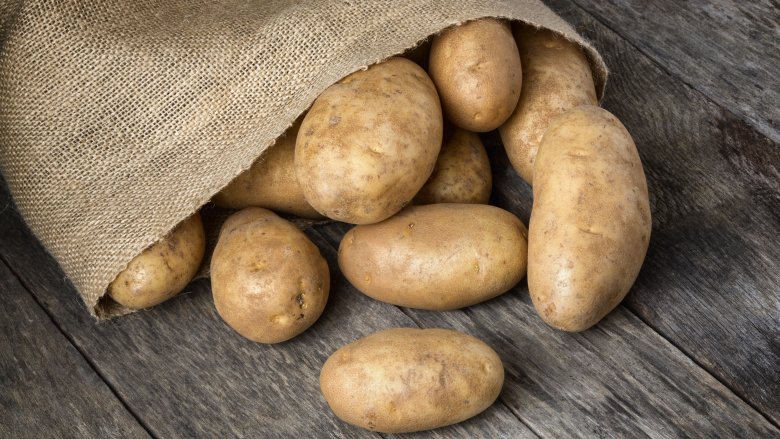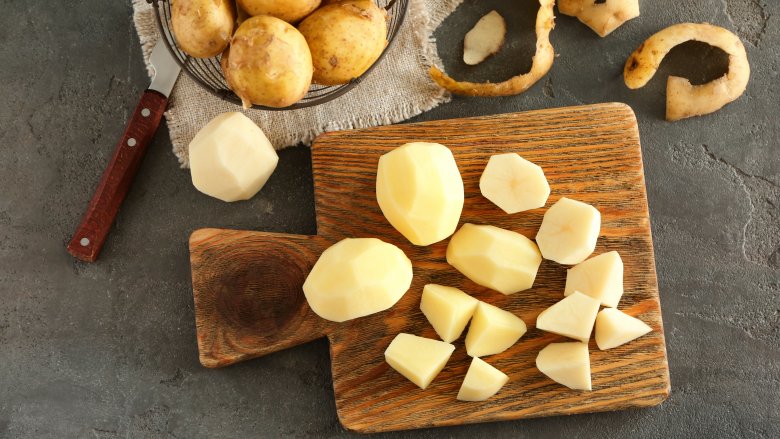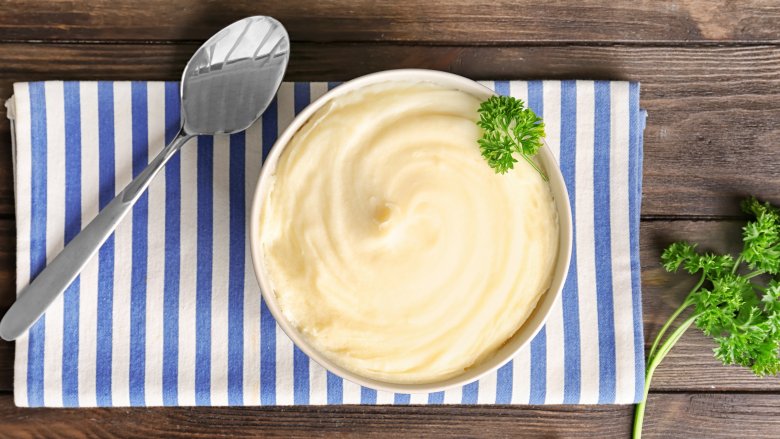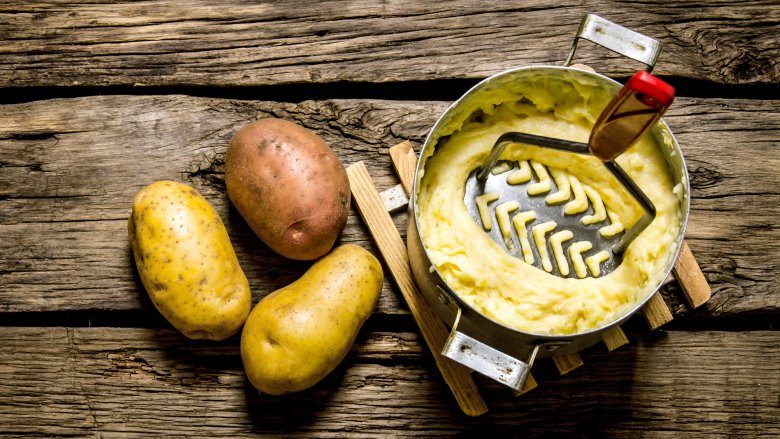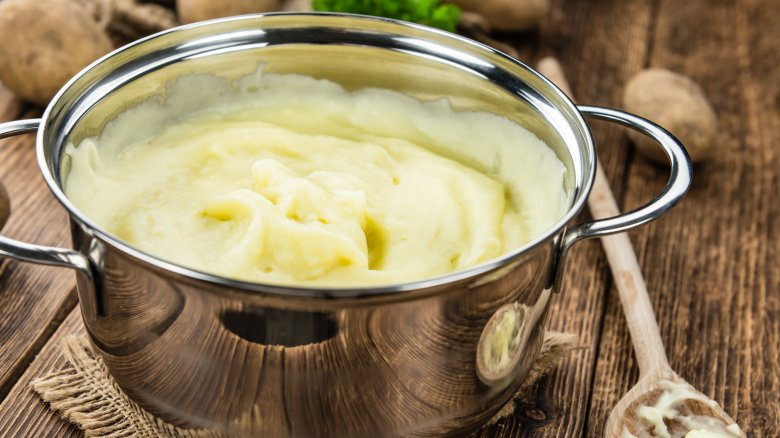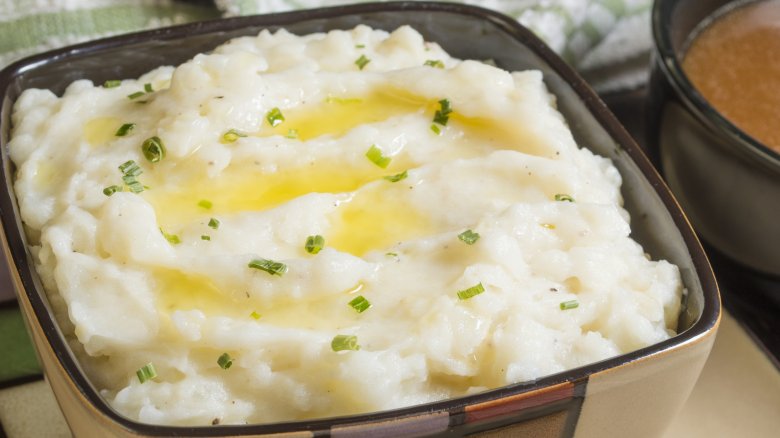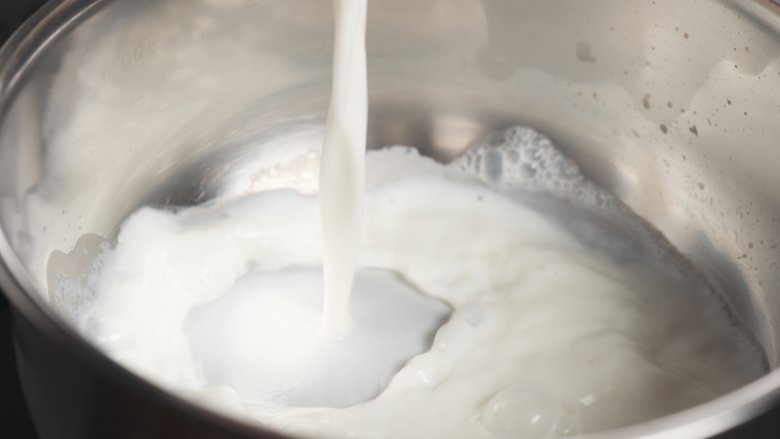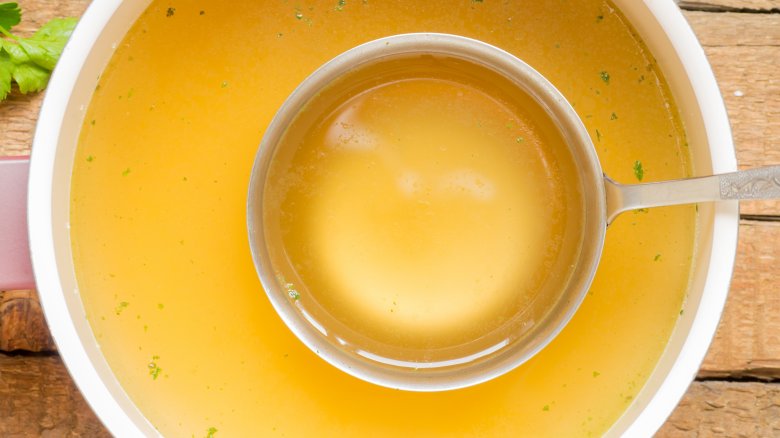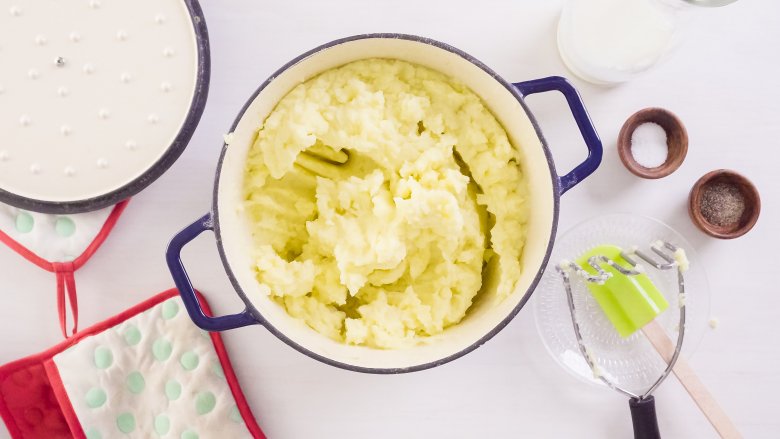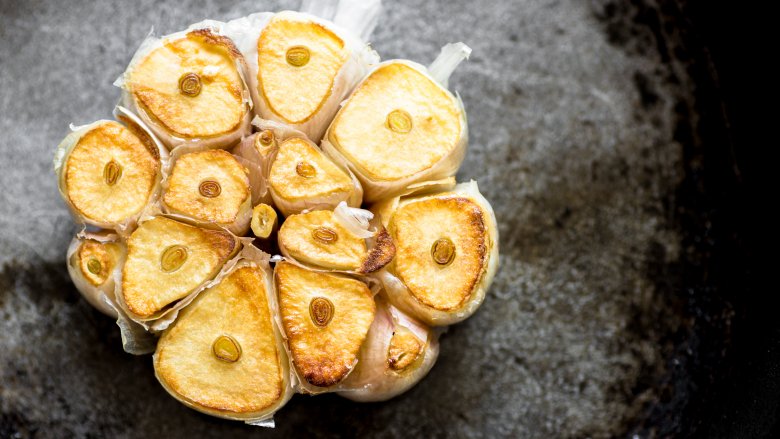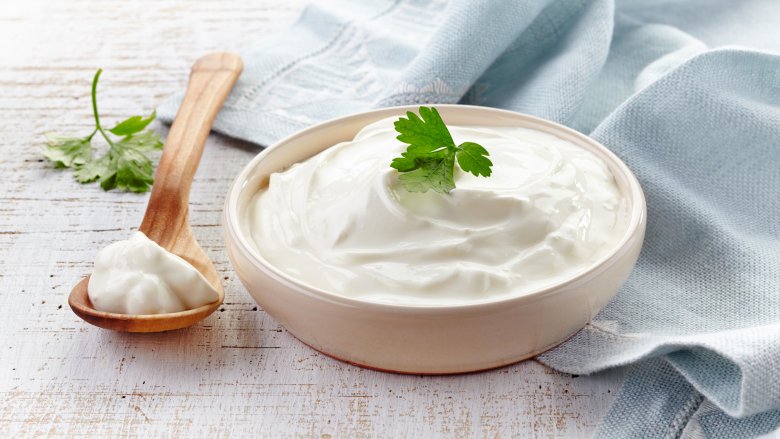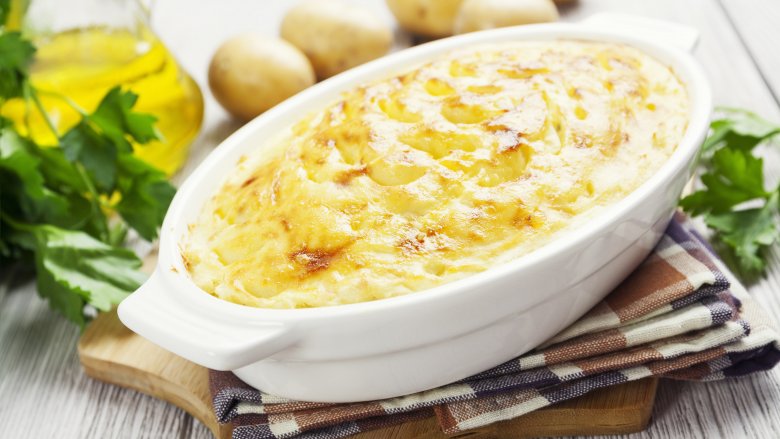Mashed Potato Secrets You Need To Know
There's a reason mashed potatoes regularly sit in the number one spot on the list of America's favorite Thanksgiving side dishes — they're somehow creamy and fluffy at the same time, delectably buttery, and happen to provide the perfect vehicle for gravy. But great potatoes shouldn't be reserved for one day a year. Whether it's a huge holiday feast or just a weekday dinner with the kids, you want to put your best foot forward when it comes to this beloved side dish.
As easy as it may sound, there's a lot to consider when making a simple batch of mashed potatoes. The kind of tuber you choose, the way you cook them, the tools you use, the flavors you add — all of it plays a part in whether your potatoes will steal the show or end up in the trash can.
And before you scoff at these tips, remember that Whole Foods can charge $8.99 a pound for mashed potatoes for a reason — some people just can't, or won't, make them.
Choose the right kind
First things first — you have to choose the best potatoes for mashing if you want the best mashed potatoes. Makes perfect sense, right?
When it comes to picking tubers, you want to go with starchy, not waxy, varieties. This means you have two solid choices: Russets (also called "Idaho") fall into the high starch category. They have a low moisture content and don't hold their shape well, which works to your advantage for mashing to light, fluffy perfection. Yukon golds, which have a medium starchiness, are sometimes preferred over Russets for their creaminess and flavor, but can lack fluffiness. To keep your mashed potatoes light as air while getting a flavor boost at the same time, use equal parts Russets and Yukon Golds.
Waxy varieties, like red or new potatoes, are firm and tend to hold their shape too well after cooking to properly mash. These are better used for potato salads or scalloped potatoes.
Don't make these cooking mistakes
Boiling a pot of potatoes might seem as simple as boiling water, but there's a bit more to it than that.
To start, you want to be sure to cut the potatoes into similarly sized pieces, otherwise they'll cook unevenly, and the larger pieces won't be cooked through. This results in unmashable bits, and nobody wants to bite into a lump of raw potato. And don't cut the pieces too small, or you'll end up with potato soup by the time they're done cooking.
Unlike with spaghetti, where you let the pot come to a boil before adding the pasta, you want to start the cooking process with the potatoes in the water. And make sure it's cold. This ensures that the whole pot comes up to temperature together, and your potatoes will cook evenly.
Lastly, don't forget the salt. Let's face it — potatoes are bland. You need to salt the cooking water with a heavy hand to give the pieces a chance to suck up some of that flavor before they get into your bowl.
Don't turn them into a gluey mess
Mashed potatoes are supposed to be creamy and fluffy, not gummy and gluey. A few lumps can be overlooked (some even prefer it), but a bowl of paste-like potatoes just crosses the line. This particular potato fail has happened to the best of us, but it's easy to avoid.
The most likely reason mashed potatoes go from heavenly clouds to a gluey mess is because they're over-processed. While it might be tempting to make quick work of a big batch with a food processor or a hand mixer*, it's not the best for the tubers. The machines break down the potato's cells and causes a release of starch — not optimal for keeping things airy.
*Though the food processor is never a good idea for mashed potatoes, a hand mixer can be used effectively if on a low speed. Just don't crank it up to 11, or you'll be in trouble. And stop as soon as the desired consistency is achieved.
Use the right tool for the job
Now that we know what not to use, let's talk about the right tools to use for potato mashing perfection.
For lumpier (rustic sounds better, doesn't it?) potatoes, a hand-held masher (or even a fork) works just fine. This method is best for small batches when you can't be bothered to bust out the more complicated tools.
For smooth-ish potatoes, a stand mixer fitted with a paddle attachment is a good way to go. Because the paddle doesn't have sharp edges, it won't give you a totally smooth consistency, but it also doesn't cause the release of starch (like a hand mixer on high speed). It's particularly useful for larger batches.
For the smoothest potatoes, drag your food mill or ricer out from the back of the cabinet — now's the time to put them to use. These tools will give you the fluffiest result, and bonus, if you don't feel like peeling potatoes, they'll do the work for you.
Keep them super fluffy
If your goal is the fluffiest mashed potatoes you ever did see, you're going to need to have a few tricks up your sleeve. We've already talked about using the right potatoes and the right tools for maximum fluff, but before you run those Russets through the ricer, there are two things you need to do:
- After you've boiled the potatoes, drain the water from the pot (use a colander to get as much water out as possible). Then return the drained potatoes to the same pot (no lid!), and put it back over medium-low heat to allow any remaining water to evaporate. This should only take a few minutes — you're not trying to cook the potatoes more, just get rid of the moisture. Water is not your friend here.
- Once drained and dry, sprinkle a pinch of baking powder over the potatoes. The leavening agent helps to form air pockets while mashing, and voila, you've got extra fluff.
Ensure they're extra buttery
Most of us make mashed potatoes by simply adding cold butter and cold milk (or cream) to the bowl and going to town with the masher. If we're feeling fancy, maybe we melt the butter and simmer the milk together on the stovetop first. But usually, that extra pan seems like a lot of extra work. Here's a case for dirtying two extra pans, and the butterific end result makes it more than worth our while.
Chef and cookbook author Diane Morgan explained her genius mashed potato hack to Food52, saying that instead of heating the butter and milk together, the better method is to heat them both separately, and add the warmed butter to the potatoes first. "The [butter] fat absorbs into the cells of the potato, which have swelled and pulled apart from one another. Then, the milk loosens and flavors the potatoes," she said. And according to Morgan, "that means you end up with a butterier tasting potato dish." Sold.
Infuse the cream with flavor
As long as you're going to the trouble of heating the cream or milk prior to adding it to your potatoes, why not take the opportunity to up your flavor game? By infusing the liquid itself, you'll add another layer of goodness to the final dish.
Since you'll just be simmering the cream and not boiling it to death, you'll want to add ingredients that pack a punch, otherwise they won't do much for the overall taste of the dish. Think about things like crushed raw garlic or chopped shallot, hearty herbs like rosemary, thyme, or bay leaves, or whole spices like peppercorns or star anise. When using especially strong flavors, be cautious — you might want a hint of star anise, for example, but it can quickly overwhelm things.
After simmering your chosen ingredients in the cream for a few minutes, strain the liquid, then add it to your potatoes and proceed with mashing as usual.
Think outside the box when boiling
Any standard mashed potato recipe will tell you to boil your potatoes in water. It's basic; it's classic; it's what we've been doing our whole lives. But it might be time to rethink that approach. When you make soup, you probably use broth as your base — after all, it instantly gives your dish more flavor than plain ol' water. So why not do the same for your mashed potatoes? There's no law that says you have to cook them in water.
Chicken or vegetable broth is a great alternative, and adds a ton of flavor to the potatoes in the cooking process. Just follow the same method you usually would, bringing the broth and potatoes to a boil together. Depending on the broth you use, be mindful of how much extra salt you add to the liquid — your broth might already be quite salty, and it's much easier to add while mashing than to fix over-salted potatoes.
Or boil them like Tyler Florence
We've covered how to add flavor by using broth, but you can take it one step further than that. This trick comes from celebrity chef Tyler Florence, who relayed his method to PopSugar, saying, "Potatoes have a really delicate, beautiful minerality to their flavor profile, and when you cook potatoes in water and you pour that water down the drain, you've extracted all the flavor of the potato. So what I do with mashed potatoes — because you finish them with cream and butter anyway, right? — is I'll take that same cream and butter and add that to the potatoes and cook the potatoes in cream and butter." He also infuses the cream with garlic and herbs.
To keep it really simple, try this riff on his original Food Network recipe: Cover the potatoes with half cream and half milk, bring to a low boil, then use as much of the cooking liquid as you need to achieve your desired consistency when mashing (you probably won't need it all). Add the butter separately.
Florence knows what he's talking about here — the result is the most distinct potato flavor you've ever tasted (and that's a good thing).
Add roasted garlic
At some point, garlic fries took over bar menus and baseball game concession stands, and we've never looked back from the addictive potato + garlic combination. But as delicious as that raw garlic flavor is, it can be a little harsh. Enter roasted garlic. Adding a whole head of this magical ingredient to your mashed potatoes will take them to the next level with all its sweet and savory caramelized flavor. Roasting garlic is simple, but it does take some time, so get this started well before you put your potatoes on.
To roast garlic, preheat the oven to 400 degrees. Cut the top off the head (keep the skins on) to expose the cloves, and put it cut side up into a small oven-proof dish. Drizzle the top with olive oil, then cover tightly with foil. Roast for about 40 minutes, until the cloves are lightly browned and soft (the cooking time will vary based on the size of the head). Let the garlic cool, then squeeze the cloves out of the skins.
Consider other tasty additions
There's no reason you have to stop at cream and butter when it comes to mashed potatoes. Adding a bit of tanginess gives this classic a whole new life. Think about additions like cream cheese, sour cream, or Boursin cheese, which not only add tang, but a ton of extra creaminess, too. Hey, Martha Stewart's mom adds cream cheese to her mashed potatoes, and if it's good enough for Big Martha, it's good enough for us.
Aside from the tang factor, there are endless ways to jazz up an otherwise ho-hum batch of potatoes:
- Add fresh herbs. Chives, basil, tarragon, or parsley will give mashed potatoes a vibrant, fresh flavor.
- Add grated cheese. You really can't go wrong with cheese — Parmesan will add a delicious saltiness, Gruyere will add a nutty creaminess, and stinky cheese lovers will drool over the addition of a pungent blue.
- And don't forget the bacon. Never forget the bacon.
And if you ruin them...
So you followed all this great advice, but for some reason your mashed potatoes didn't turn out. Before you relegate them to the garbage can, there are a couple things you can do to salvage things.
If the potatoes turned out watery, either from lack of drainage or because you were a bit overzealous with the milk, you can likely fix them. All you need to do is put them back on the stovetop over low heat to allow the moisture to cook out. But be careful — you'll need to stir frequently so they don't burn, but you don't want to overwork them either, or you'll go from watery mess to gluey disaster.
Speaking of gluey disasters... there's a fix for that, too. Spread your paste-like potatoes into a baking dish and turn it into a gratin. Add a few dabs of butter and a handful of grated cheese and/or breadcrumbs on top, and bake until crisp. Then act like you meant to do exactly that.
